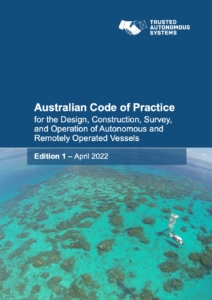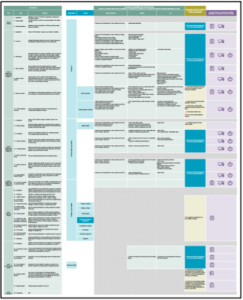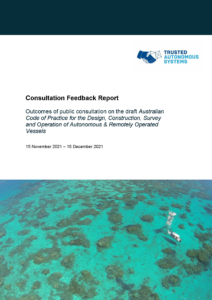Release of the Australian Code of Practice for the Design, Construction, Survey and Operation of Autonomous & Remotely Operated Vessels
By Rachel Horne, Assurance of Autonomy Activity Lead, TAS
Trusted Autonomous Systems (TAS) has released the Australian Code of Practice for the Design, Construction, Survey and Operation of Autonomous & Remotely Operated Vessels, Edition 1 (‘Australian Code of Practice’).
The Australian Code of Practice provides a best practice standard tailored for autonomous and remotely operated vessels operating in Australia. It is a voluntary standard, developed in close consultation with the Australian Maritime Safety Authority (AMSA), intended to be used to support assurance, accreditation, and safe operations.

Access the Australian Code of Practice and Guidance Materials via the TAS website.
The development of the Australian Code of Practice was informed by an analysis of existing, publicly available codes and guidelines for autonomous and remotely operated vessels[1], significant stakeholder engagement, and public consultation.
TAS, supported by Australian Maritime College Search, have also developed a suite of Guidance Materials to support the use of the Australian Code of Practice. These Guidance Materials explain how the Australian Code of Practice fits into the existing Australian maritime regulatory framework, how to use the Code, and what the requirements are for each category of vessel, together with providing examples and suggestions on where to access further information.
TAS encourages owners, operators, surveyors, regulators and other users of the Australian Code of Practice and Guidance Materials to provide feedback to TAS, to help inform future iterations.
Where can I get more information?
To access more information on the Australian Code of Practice, you can:
- Download Edition 1 of the Australian Code of Practice and Guidance Materials
- Download the Public Consultation Report
- View previous TAS website articles on this project:
- New TAS project to develop an Australian Code of Practice for the Design, Construction, Survey and Operation of Autonomous and Remotely Operated Vessels in 2021
- Outcomes of successful webinar on TAS’s project to develop an Australian Code of Practice for the Design, Construction, Survey and Operation of Autonomous & Remotely Operated Vessels in 2021
- TAS Report: Analysis of available standards and codes for autonomous and remotely operated vessels
- Enabling COLREGs compliance for autonomous & remotely operated vessels
- Public consultation commences on draft Australian Code of Practice for the Design, Construction, Survey and Operation of Autonomous & Remotely Operated Vessels
- Email us at info@tasdcrc.com.au
TAS would like to thank all parties who contributed to the development of the Australian Code of Practice, including particularly Maaike Vanderkooi of Vanderkooi Consulting who led the development of the Code on TAS’s behalf, Rob Dickie of Frazer Nash Consultancy who led the COLREGs project on TAS’s behalf, together with his team Marceline Overduin and Andrejs Jaudzems, and Chris White from AMC Search who led delivery of the Guidance Materials, together with his team Reuben Kent, Damien Guihen, and Nick Bonser.
This project received funding support from the Queensland Government through Trusted Autonomous Systems (TAS), a Defence Cooperative Research Centre funded through the Commonwealth Next Generation Technologies Fund and the Queensland Government.
[1] UK Code of Practice for Maritime Autonomous Surface Ships, the LR Code for Unmanned Marine Systems, and DNV GL’s Autonomous and Remotely-operated Ships Class Guideline


